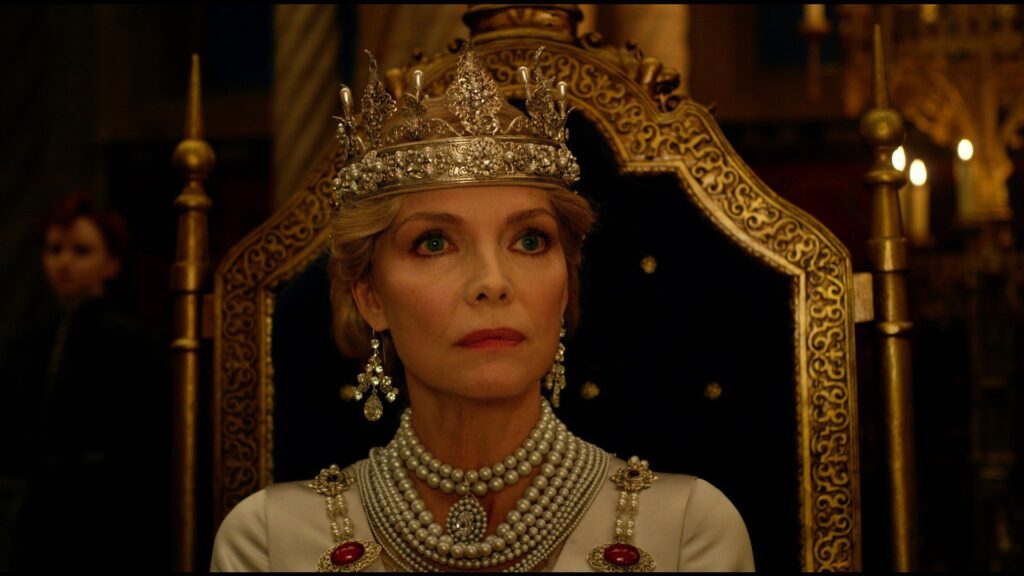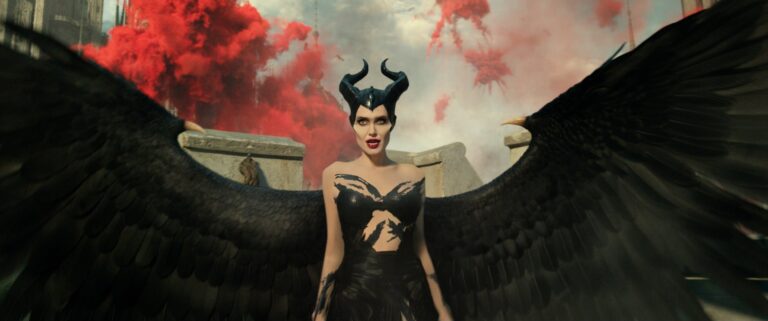After Maleficent grossed $758 million worldwide — building the foundation for the seemingly endless parade of remakes, revisions and reimaginings of the studio’s animated catalog — another film starring Angelina Jolie as the iconic Disney villain was inevitable. But whereas the first offering was an underwhelming variation on Sleeping Beauty elevated by a delightfully wicked performance from Jolie, Maleficent: Mistress of Evil is a failure at practically every level.
Five years have passed, and as Aurora (Elle Fanning) reigns over the Moors, Phillip (Harris Dickinson, replacing Brenton Thwaites due to scheduling conflicts) dreams of uniting their kingdoms through marriage, creating peace between humans and the fairies. When Phillip finally musters the courage to ask for Aurora’s hand, the young queen is delighted — until Maleficent flatly vetoes the union. “Love doesn’t always end well,” she warns, but Aurora stands her ground, convincing her godmother to accompany her to dinner with the royal family.
King John (Robert Lindsay) is amiable enough, but the icy Queen Ingrith (Michelle Pfeiffer, doing her best Cersei Lannister impression) pokes and prods the sorceress until Maleficent loses her temper, rising from her seat in a cloud of crackling green magic and decreeing the wedding shall not take place. Just as she makes this pronouncement, King John slumps to the floor and falls into a deep slumber, and Maleficent once more finds herself accused of enacting a curse on a member of a royal family.
But things are not quite as they seem, and before we go any further, it seems prudent to issue a word of caution: in the paragraphs below, I’ll be frankly discussing some of the major plot elements of Maleficent: Mistress of Evil. Continue reading at your peril.
WARNING: SPOILERS BELOW

In truth, Maleficent has nothing to do with the King’s illness, and the entire dinner fiasco was carefully orchestrated by Queen Ingrith to goad the sorceress into a fight. The queen has secretly been amassing weapons to wage war against the Moorfolk, who she regards as “savages,” dismissing them as “creatures who can barely grunt, let alone engage in talks.” She brands Aurora “a traitor to your kind” for electing to live among the fairies instead of with the humans, and even employs a henchman named Lickspittle (Warwick Davis) to devise a weapon that can kill fairies in massive quantities. As if to drive the point home even further, Ingrith’s abhorrent views are reinforced by the film’s iconography — the kingdom over which she reigns is mostly full of white faces, while the exiled band of Fey that come to Maleficent’s aid (led by Chiwetel Ejiofor) is overwhelmingly comprised of minorities, including a handful whose shimmering rainbow-colored plumage is clearly meant to evoke the LGBT community.
So hellbent is the Queen on wiping out every last remnant of the Moorfolk that she uses the impending nuptials between Aurora and Phillip to stage the film’s equivalent of the “Red Wedding,” the infamous massacre of the Stark family in Game of Thrones. This sequence isn’t just an homage, it’s a blatant recreation, right down to armor-clad soldiers barring the doors and a performer segueing into a somber piece of music as the slaughter begins. Whimsical creatures of all shapes and sizes run screaming for the exit as Ingrith’s biological weapon snuffs out life all around — if you want a little genocide in your fairy tale, then Maleficent: Mistress of Evil is the movie for you!
Jokes aside, there’s something incredibly disturbing about a character in a Disney film — villain or otherwise — carrying out actions and using language that so closely echoes that of racists and white nationalists. Ingrith hates the Moorfolk for no other reason than her family was once poor while the fairies were not, and bitterly recalls her father’s refusal decades earlier to invade the Moors and take their resources by force. She views them as disposable, an obstacle standing in the way of her kingdom’s prosperity, and at one point readily admits to crafting a narrative of fear to rile up her subjects and convince them of the imminent threat represented by Maleficent and her kind. It all feels so alarmingly out of place in a Disney film, despite one character’s proclamation — almost directly into this camera — that “this is no fairy tale.”
Much like the first film, Jolie’s sharp-tongued performance is the most enjoyable element of the sequel, but she’s frustratingly shuffled to the back burner for most of the second act and saddled with a lengthy mythology-building subplot about the history of the exiled Fey. This material could have been compelling had it been given ample room to breathe, but paired with Ingrith’s scheming and politicking en route to a full-on race war, it feels thin and underdeveloped. The film also fails to satisfying deliver on the promise of an epic Jolie and Pfeiffer face-off: aside from the aforementioned dinner scene, the two legends share almost zero screentime together.
And while you can be sure the titular sorceress will emerge victorious — it’s her name on the marquee, after all — the film never reckons with the death and destruction left in Ingrith’s wake as dozens (if not hundreds) of fairies, pixies and other magical creatures are murdered in the chapel or struck down in the third act’s massive battle sequence. Maleficent: Mistress of Evil may have the dubious honor of becoming the Disney film with the highest body count, but that’s about the only distinction worth bestowing upon it.

